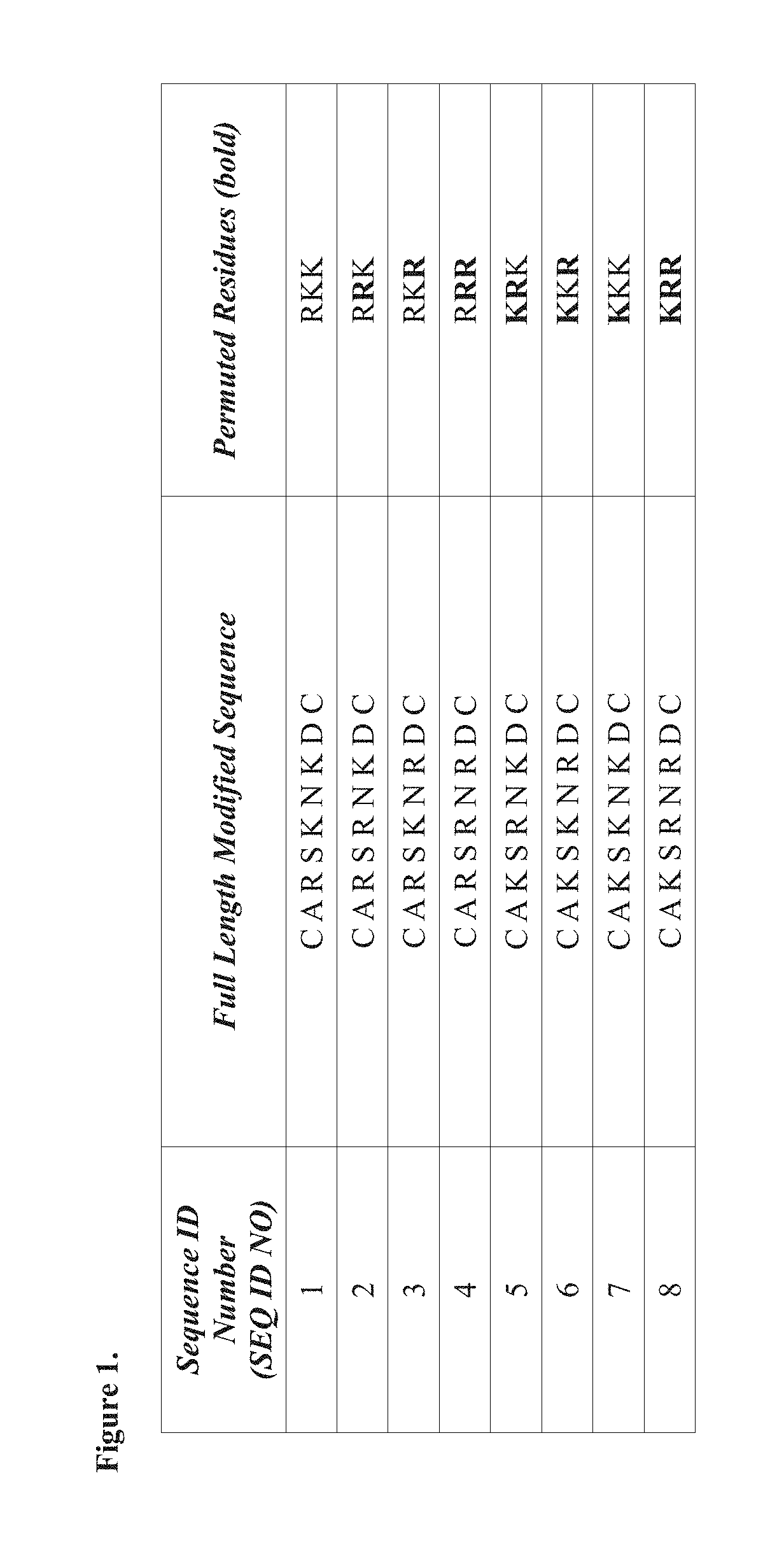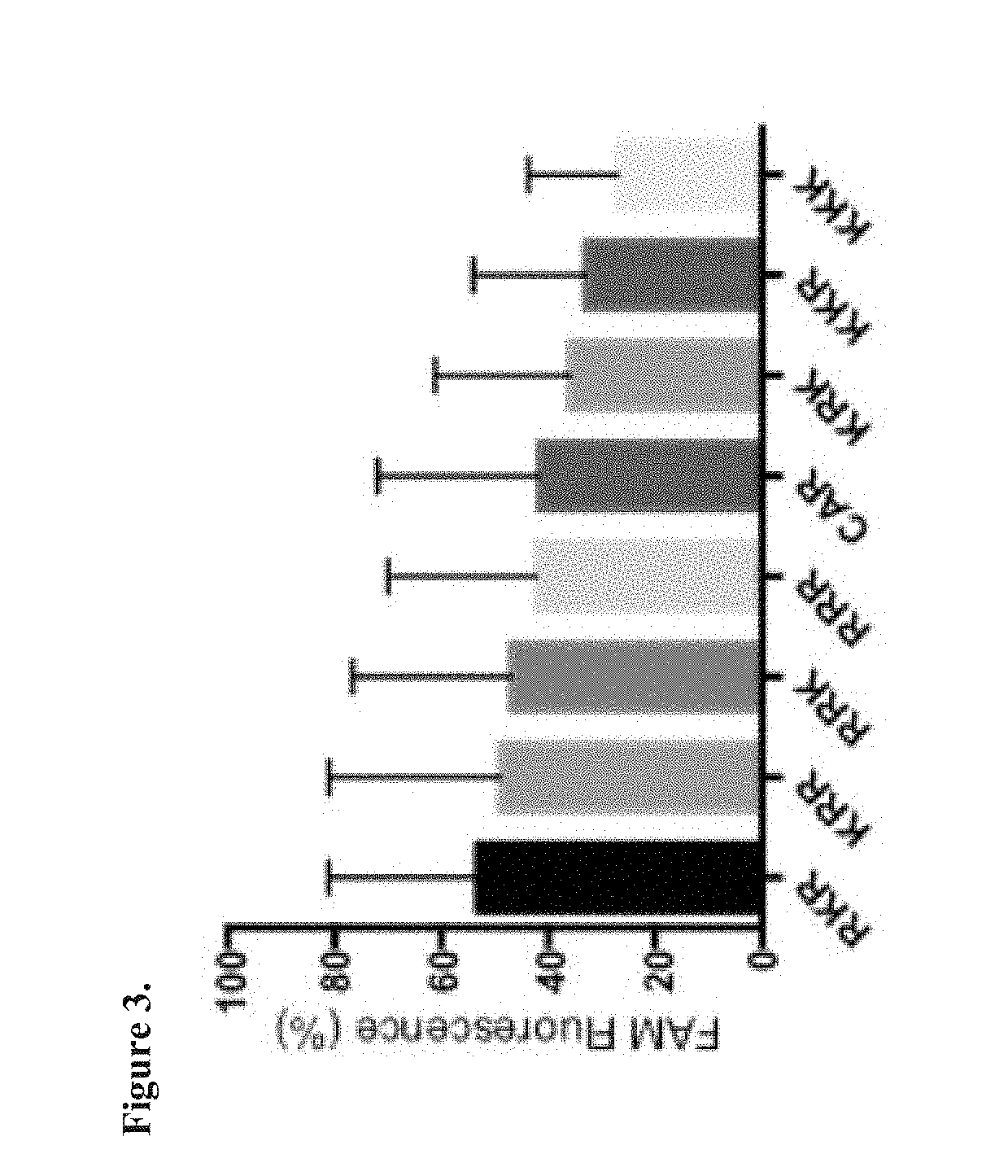Compositions Containing a Pharmacophore with Selectivity to Diseased Tissue and Methods of Making Same
a technology of pharmacophore and diseased tissue, applied in the field of drug discovery and development, can solve the problems of severe underreporting of sepsis, high mortality rate of sepsis, and relative lack of agents that can selectively target the diseased tissue, so as to reduce the amount of scar tissue, reduce inflammation, and increase the speed of wound healing
- Summary
- Abstract
- Description
- Claims
- Application Information
AI Technical Summary
Benefits of technology
Problems solved by technology
Method used
Image
Examples
example 1
ation of the Cyclic CAR Pharmacophore
[0137]In an attempt to identify the cyclic CAR pharmacophore, cell binding and internalization assays for CAR peptide (SEQ ID NO: 1) and seven closely related peptides (SEQ ID NOs: 2-8) were performed.
[0138]1A. Confocal Microscopy.
[0139]Eight CAR variants (SEQ ID NOs: 1-8) with permutations on either the lysine or arginine residues were synthesized (FIG. 1). The peptides were labeled by attaching a fluorescamine (FAM) group to the molecule.
[0140]A cell binding and internalization assay was used as an initial test to compare the variants to the original CAR peptide. Cell binding / internalization by the CAR peptide variants was studied by confocal microscopy using Chinese Hamster Ovary (CHO-K) cells, which have been previously used to study CAR binding.
[0141]FAM-conjugated peptides as indicated were incubated at 5 μM concentration with CHO-K cells for 2 hours. The cells were washed, fixed, stained with the nuclear stain DAPI. The CHO cell binding an...
example 2
of Novel Non-Peptide Compounds that Possess the Cyclic or Linear CAR Pharmacophore Using Peptidomimetics
[0154]2A. In Silico Generation and Virtual Rendering of SEQ ID NOs: 9-11 and 13-15.
[0155]In an effort to illustrate a peptidomimetic approach that could be taken to create a novel compound that possesses the CAR pharmacophore, a small compound library in silico was generated using PyMOL Molecular Graphics System, Version 1.2r2 (PyMOL 2014). Six structures have been designed to contain the CAR pharmacophore required for disease homing and selective internalization. Utilizing a rational approach to mimic CAR's molecular properties, all six of the analogues were produced from three existing, widely available therapeutics: voclosporin, rapamycin, and rifabutin. Three cyclic variants were produced containing the cyclic CAR pharmacophore (SEQ ID NOs: 9-11), and three linear variants were produced which contain the linear CAR pharmacophore (SEQ ID NOs: 13-15).
[0156]Although certain aspec...
example 3
of Novel Peptide Substitutional Variants Containing the Cyclic, Linear, and Truncated CAR Pharmacophore
[0162]3A. In Silico Generation and Virtual Rendering of SEQ ID NOs: 16-19, 20-23, and 25-28.
[0163]In an effort to illustrate a substitutional approach that could be taken to create novel peptides that possesses the CAR pharmacophore, a focused compound library in silico was generated using PyMOL Molecular Graphics System, Version 1.2r2 (PyMOL 2014). In this example, all cyclic, linear, and truncated analogues that were generated contain unnatural amino acid substitutions. The specific unnatural amino acid residues used, as well as their location within the CAR peptide sequence, were all deliberately chosen, in order to produce novel analogues that still retain the CAR pharmacophore. SEQ ID NOs: 16-19 were designed to fit the cyclic CAR pharmacophore, SEQ ID NOs: 20-23 were designed to fit the linear CAR pharmacophore, and SEQ ID NOs: 25-28 were designed the truncated CAR pharmacoph...
PUM
| Property | Measurement | Unit |
|---|---|---|
| Therapeutic | aaaaa | aaaaa |
| Selectivity | aaaaa | aaaaa |
Abstract
Description
Claims
Application Information
 Login to View More
Login to View More - R&D
- Intellectual Property
- Life Sciences
- Materials
- Tech Scout
- Unparalleled Data Quality
- Higher Quality Content
- 60% Fewer Hallucinations
Browse by: Latest US Patents, China's latest patents, Technical Efficacy Thesaurus, Application Domain, Technology Topic, Popular Technical Reports.
© 2025 PatSnap. All rights reserved.Legal|Privacy policy|Modern Slavery Act Transparency Statement|Sitemap|About US| Contact US: help@patsnap.com



